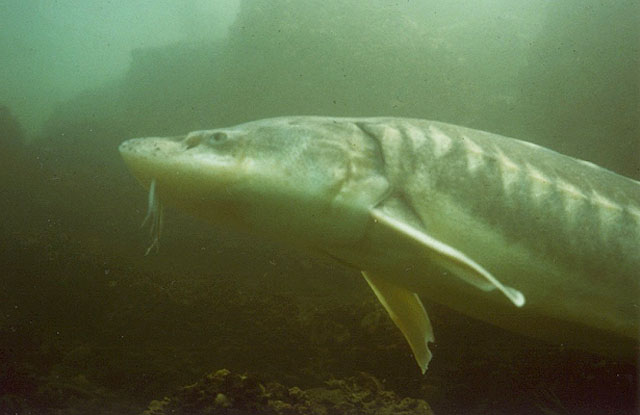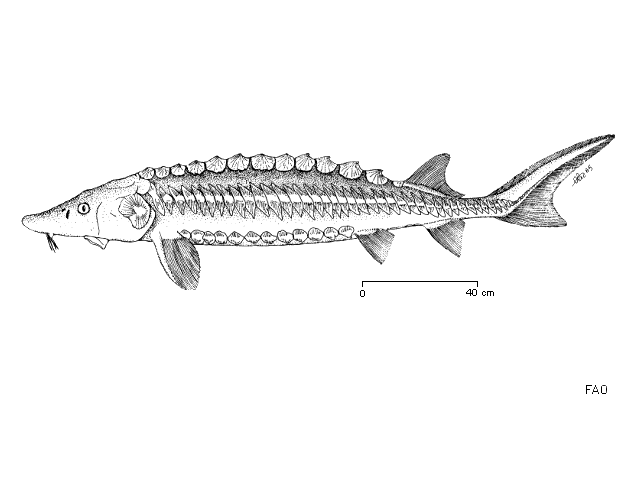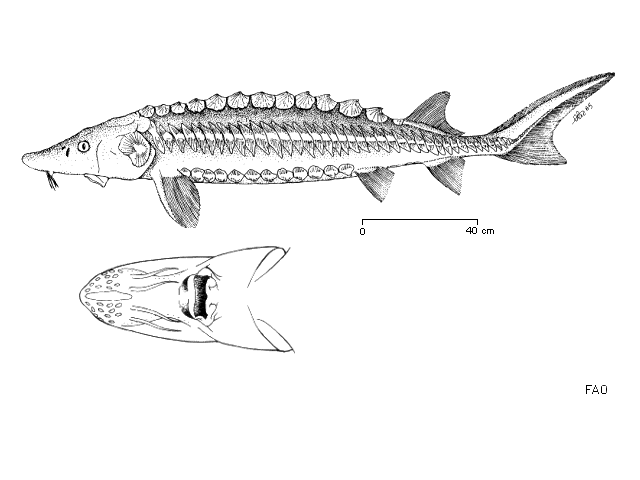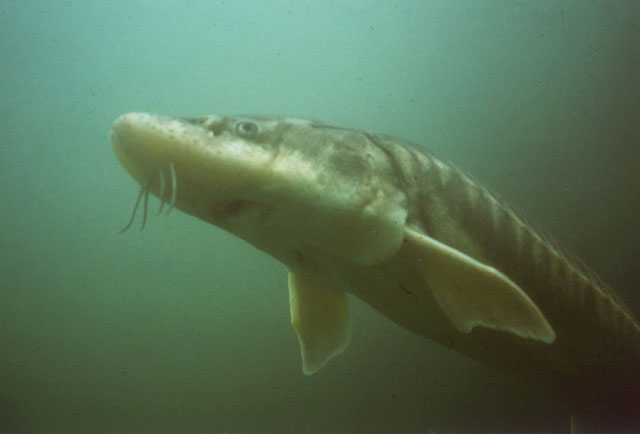Acipenser
naccarii
Bonaparte,
1836
Adriatic sturgeon
View all media / Upload your photos and videos
Expand all
Classification / Names
Chondrostei (sturgeons) > Acipenseriformes (Sturgeons and paddlefishes) >
Acipenseridae (Sturgeons)
> Acipenserinae
Etymology: Acipenser: Latin, acipenser = sturgeon, 1853 (Ref. 45335).
More on author:
Bonaparte.
Environment / milieu / depth range / climate zone / distribution range
Distribution
Europe: Adriatic Sea and its tributaries between Po (Italy) and Buna (Albania) drainages. Recorded from Corfu; present in lowermost part of Adriatic rivers from Soca to Drin. Records from Tyrrhenian slope of Italy, Spain and France are erroneous.
Maps

Acipenser naccarii / Native range
AquaMaps Data sources:
GBIF
OBIS
This map was computer-generated and has not yet been reviewed.

Acipenser naccarii / Suitable habitat
AquaMaps Data sources:
GBIF
OBIS
This map was computer-generated and has not yet been reviewed.

Acipenser naccarii / Point map
AquaMaps Data sources:
GBIF
OBIS
This map was computer-generated and has not yet been reviewed.

Acipenser naccarii / Year 2050
AquaMaps Data sources:
GBIF
OBIS
This map was computer-generated and has not yet been reviewed.
Size / Weight / Age
Short description
Dorsal spines (total): 0; Dorsal soft rays (total): 36 - 48; Anal soft rays: 24 - 31. Snout moderate, very broad and rounded at tip. Lower lip continuous, interrupted at center. Barbels nearer to tip of snout than to mouth and not touching it. Five rows of scutes, dorsal 10-14 (the middle ones deeper and usually larger than those at front), lateral 32-42 on each side, ventral 8-11 on each side, with no smaller plates between dorsal and lateral rows. Back is olivaceous brown, flanks lighter, belly white.
Biology
Occurs in the sea close to shore and estuaries, not entering pure marine waters. In freshwater, it inhabits large deep rivers (Ref. 59043). A long-lived species which is found mainly over sand and mud. Feeds on bottom-living invertebrates and small fishes. Reproduction takes place from May to July. Is threatened by habitat destruction, pollution and overfishing (Ref. 26100). The flesh is used for food (Ref. 6866) and eggs used for caviar production (Ref. 128183).
Life cycle and mating behavior
Enters rivers from March to May, and presumably spawns then.
Main reference
Kottelat, M. and J. Freyhof 2007 Handbook of European freshwater fishes. Publications Kottelat, Cornol and Freyhof, Berlin. 646 pp. (Ref. 59043)
IUCN Red List Status (Ref. 125652)
Critically Endangered (CR), A2bcde; date assessed: September 14 2019
CITES (Ref. 131153)
Appendix II: International trade monitored
CMS (Ref. 116361)
Appendix II: Migratory species conserved through agreements
Threat to humans
Harmless
More information
- Countries
- FAO areas
- Ecosystems
- Occurrences
- Introductions
- Stocks
- Ecology
- Diet
- Food items
- Food consumption
- Ration
- Common names
- Synonyms
- Metabolism
- Predators
- Ecotoxicology
- Reproduction
- Maturity
- Spawning
- Spawning aggregation
- Fecundity
- Eggs
- Egg development
- Age/Size
- Growth
- Length-weight
- Length-length
- Length-frequencies
- Morphometrics
- Morphology
- Larvae
- Larval dynamics
- Recruitment
- Abundance
- References
- Aquaculture
- Aquaculture profile
- Strains
- Genetics
- Allele frequencies
- Heritability
- Diseases
- Processing
- Mass conversion
- Vision
- Pictures
- Stamps, Coins Misc.
- Sounds
- Ciguatera
- Speed
- Swim. type
- Gill area
- Otoliths
- Brains
Estimates based on models
Preferred temperature (Ref. 123201): 14.7 - 18.2, mean 17.4 °C (based on 12 cells).
Phylogenetic diversity index (Ref. 82804): PD50 = 0.5 [Uniqueness, from 0.5 = low to 2.0 = high].
Bayesian length-weight: a=0.00295 (0.00131 - 0.00665), b=3.18 (3.00 - 3.36), in cm total length, based on LWR estimates for this Genus-body shape (Ref. 93245).
Trophic level (Ref. 69278): 3.4 ±0.5 se; Based on food items.
Resilience (Ref. 120179): Very low, minimum population doubling time more than 14 years (Preliminary K or Fecundity.).
Fishing vulnerability (Ref. 59153): Very high vulnerability (90 of 100).
Price category (Ref. 80766): Unknown.
Nutrients (Ref. 124155): Calcium = 16.9 [10.0, 29.8] mg/100g; Iron = 0.256 [0.156, 0.410] mg/100g; Protein = 17.5 [14.9, 20.1] %; Omega3 = 0.33 [0.18, 0.59] g/100g; Selenium = 18.3 [9.3, 35.5] μg/100g; VitaminA = 6.4 [2.3, 17.8] μg/100g; Zinc = 0.53 [0.38, 0.73] mg/100g (wet weight);




